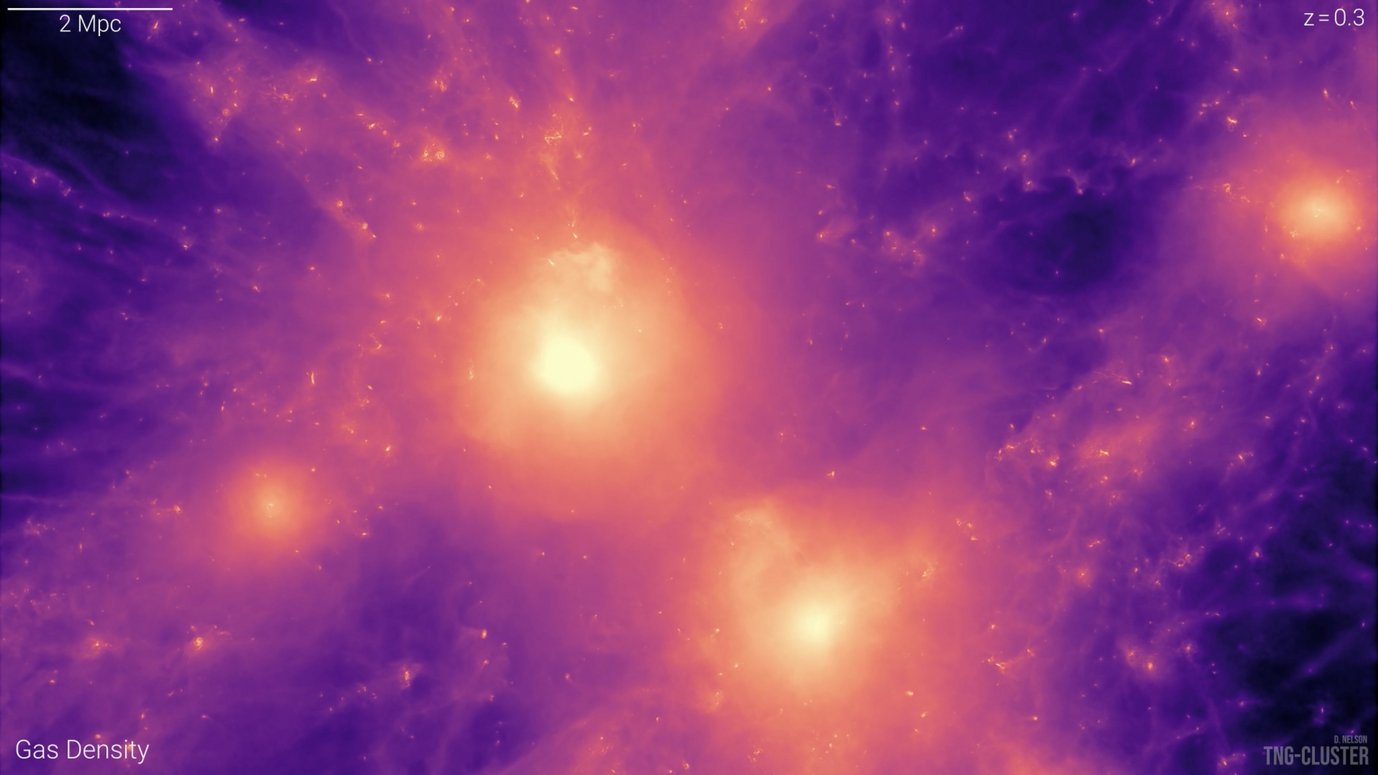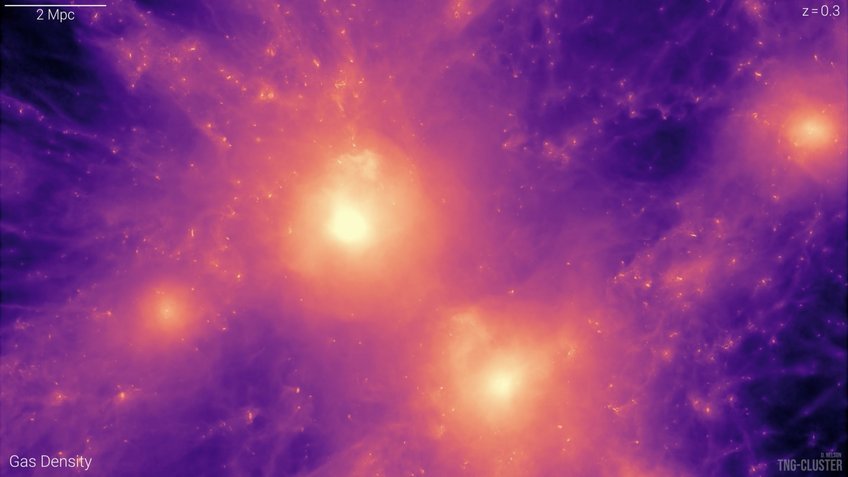TNG-Cluster simulates the most massive structures in the cosmos
Heidelberg-based researchers have published data for the largest detailed simulation of the formation and evolution of massive galaxy clusters in the cosmos. The simulation uses a clever technique that allowed the researchers to obtain a sample of several hundred simulated massive clusters, with each cluster simulated in considerable detail. The simulation has already led to a number of insights into the physics of galaxy clusters. Now, its data is published in full, allowing other scientists to use this model universe for their research.

A new large-scale cosmological simulation, TNG-Cluster has successfully probed the realm of the largest gravitationally-bound structures in the universe: gigantic clusters containing numerous galaxies, with a total mass of a million billion solar masses or more. The simulation is the first to yield a sample of clusters that is sufficiently large – 92 clusters of the most massive variety – to allow for systematic studies and statistical analysis, including comparisons with the population of massive galaxy clusters that observational astronomers have been able to observe and to study. The simulation is a project by researchers from the Max Planck Institute for Astronomy (MPIA) and Heidelberg University’s Institute for Theoretical Astrophysics (ITA) in the framework of the TNG Collaboration.
Grappling with a basic trade-off
In creating their model universe, the researchers had to grapple with the basic trade-off faced by all cosmological simulations: For one, the model cosmos should be sufficiently large to allow conclusions about the universe as a whole. This is particularly important for the most massive clusters, which are very rare. The previous version of the simulation, TNG300, had contained a mere 3 such giant clusters. But if we want to understand the physical processes taking place, simulations need to show sufficiently fine details. Increasing the size and the level of details both increase the needed computing power. Since the available computing power is limited, researchers are usually forced to choose between a large, less detailed model universe, and a smaller one showing finer details.
For TNG-Cluster, the researchers found a clever work-around. In a first step, they simulated a large universe, a cube more than 3 billion light-years a side, filled only with dark matter. Given that dark matter accounts for 80% of the total mass of matter in the universe, with ordinary matter such as atoms providing the other 20%, the way that dark matter clumps together, forming denser regions known as halos, is almost completely independent of the presence of gas or stars.
Zooming in on cluster details
Once they had let their dark matter universe evolve to the present time, the researchers identified 352 regions where the largest galaxy clusters in their model universe are located. For each of those objects, as well as their immediate neighbourhoods, the researchers then reran the simulation separately, but this time including gas, stars and the central supermassive black holes in the centers of galaxies, in fine detail. For their last step, the researchers embedded those hundreds of separate, detailed simulations in their larger, original model universe.
“This creates a unique scientific dataset”, says Co-PI of the project Dylan Nelson of the Institute for Theoretical Astrophysics, which is part of the Center of Astronomy of Heidelberg University. “It allows us, and researchers worldwide, to not only study a large sample of galaxy clusters, but also to resolve small-scale details within each cluster. This includes not only the galaxies that make up the clusters, but also the processes in the gas of the hot intracluster medium.”
Where those processes are concerned, TNG-Cluster is unique in its ability to follow the evolution and amplification of magnetic fields. Cluster gas is ionized, forming a plasma, with the positively charged protons and negatively charged electrons of the hydrogen separated. Magnetic fields may well be crucial for shaping the flows of matter and energy in such clusters – and they may well be crucial in shaping some of the observable features of clusters.
A comprehensive simulation of galaxy clusters
The result is a simulation that has it all. It is larger than previous simulations, and thus contains a great number of massive clusters. But the clusters themselves are simulated in great detail, allowing the researchers to trace various properties: the characteristics of the gas that forms the “intracluster medium”, including about a dozen elements of the periodic table; how frequently the various different types of galaxies are found inside the massive clusters, and in their direct neighbourhood, and the masses of the supermassive black holes in their centers; and last but not least the detailed assembly process that brought all those components together over the course of cosmic history.
The variety of clusters is large enough to allow the researchers to identify analogues of particularly interesting galaxy clusters: of the so-called Bullet Cluster, where we see the merging of two sub-clusters, or of “El Gordo” (literally “The Fat One”), a cluster that seven billion years ago had already reached the remarkable mass of two million billion solar masses.
Black-hole driven feedback
The group that created TNG-Cluster, and is now sharing their data publicly, has already done considerable analysis work themselves on their model universe. Some of the results have been unexpected, in a good way. Supermassive black holes can become active if there is matter falling into them, with their immediate surroundings forming an “active galactic nucleus” that injects considerable energy into the surrounding space. On the scale of galaxy clusters, the interaction of such energy injections with the cluster gas leads to distinctive features: cavities that are blown almost clear of material, shocks where portions of gas flowing in different directions collide, and density waves travelling through the gas like ripples.
While the TNG simulations do an impressive job of capturing details within a large simulated volume of the cosmos, the processes near supermassive black holes happen on scales that are too small even for TNG. At least at this stage, the energy that active galactic nuclei inject into their surroundings is modelled in a drastically simplified way. That is why the researchers were somewhat surprised to find that even with this simplification, their model reproduces the cavities in the plasma of massive galaxy cluster quite realistically. In observations, cavities like this can be seen as “X-ray cavities” – regions that, as opposed to the rest of the cluster gas, do not emit X-rays. “The properties of the simulated cavities match the properties of their observed counterparts quite nicely!” says Annalisa Pillepich of the Max Planck Institute for Astronomy, Co-PI of the TNG-Cluster project. “This is a notable confirmation that the model is working well." Evidently, the formation of cavities in massive clusters is rather robust, and does not depend on the details of the physics of active galactic nuclei. The result showcases the kinds of insights that scientists can gain from simulations like TNG-Cluster.
TNG-Cluster for everybody
It has always been the practice of the collaboration of scientists producing the TNG simulations, of which TNG-Cluster is a spin-off project, to share not only their own results, but all of the information about their simulated model universe with the scientific community. In fact, of the more than 1000 publications to date based on TNG data, more than 700 have been authored by scientists outside the group of TNG builders.
TNG-Cluster is now being shared freely as well: Starting today, scientists and the public will be able to access the synthetic universe of this simulation, including hundreds of Terabytes of data, on the TNG website: https://www.tng-project.org/data/. The data release is accompanied by a number of scientific publications, which add to about another dozen TNG-Cluster articles previously published by the Heidelberg-based teams (https://www.tng-project.org/cluster/#results).
